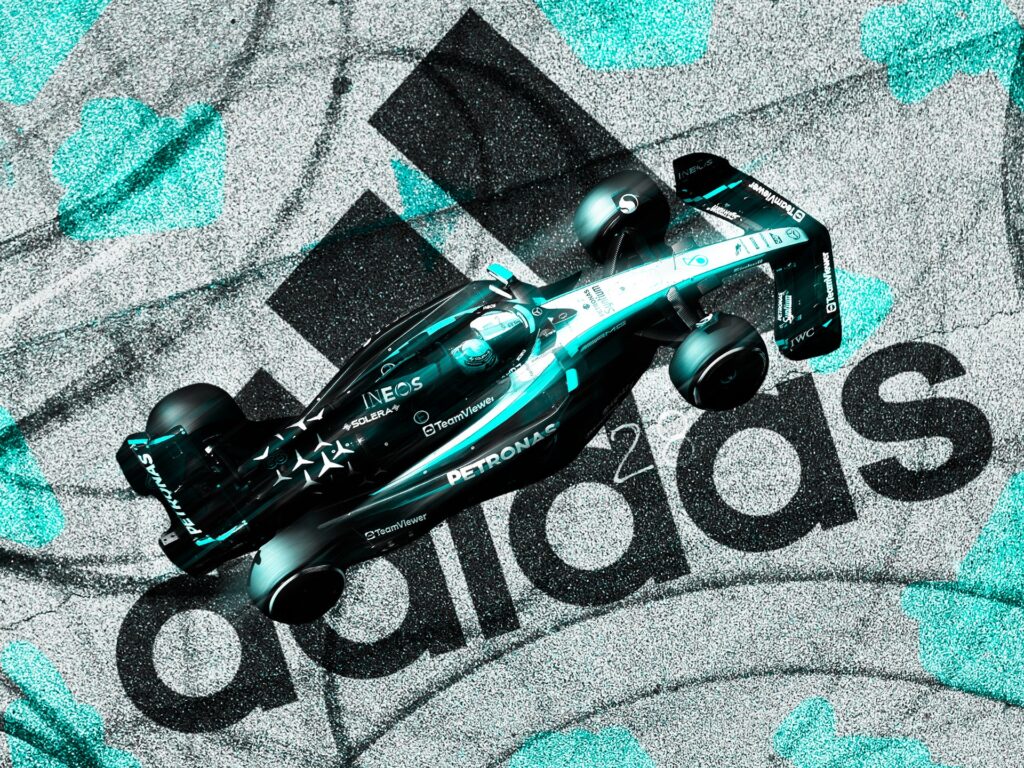The 2025 Formula 1 season marks a defining era for Mercedes-AMG Petronas Formula 1 Team, a name synonymous with dominance in the turbo-hybrid era. After years of unparalleled success, the team faces a season of reinvention both on and off the track. With the departure of their legendary driver Lewis Hamilton to Ferrari, George Russell’s rise to lead driver status, and a bold decision to switch long-standing sponsorships, Mercedes is not just adapting to change—it’s embracing it.
Among the most notable shifts is Mercedes’ decision to part ways with Puma and Tommy Hilfiger, long-time partners that have defined the team’s visual and commercial identity for years. Instead, the team has entered into a groundbreaking partnership with Adidas, a move that symbolizes not only a change in branding but a broader cultural shift in the world of motorsport. This essay explores the significance of this transition, its implications for Mercedes and Adidas, and how it fits into the broader narrative of Formula 1 and its commercial ecosystem.
Lewis Hamilton’s Departure: The Catalyst for Change
No discussion of Mercedes’ 2025 transformation can begin without acknowledging the departure of Lewis Hamilton, one of the most iconic figures in the sport’s history. After spending more than a decade at Mercedes, Hamilton’s move to Ferrari sent shockwaves through the Formula 1 community. The seven-time world champion not only brought unparalleled success to Mercedes but also shaped its global brand image. His charisma, activism, and on-track brilliance made him an ambassador for the team and the sport.
Hamilton’s departure signals the end of an era for Mercedes, but it also opens the door for George Russell to step into the spotlight as the team’s first driver. A prodigious talent, Russell has long been groomed as Hamilton’s successor. The 2025 season will test his ability to lead the team both competitively and culturally, ushering in a new chapter for Mercedes.
From Puma to Adidas: A Strategic Shift
While Hamilton’s departure marks a change in personnel, Mercedes’ decision to switch apparel partners from Puma to Adidas represents a shift in the team’s commercial and cultural strategy. For years, Puma has been the dominant force in motorsport apparel, providing uniforms, shoes, and fan gear to multiple Formula 1 teams, including Ferrari, Alfa Romeo, and Williams, as well as teams in other racing circuits like Porsche and BMW.
Puma’s longstanding partnership with Mercedes was highly successful, reflecting the brand’s expertise in motorsport. The German sportswear giant’s deep connections in Formula 1 have allowed it to create innovative designs that balance functionality with style, appealing to drivers and fans alike. Despite this, Mercedes’ decision to align with Adidas—a rival with a different cultural footprint—signals a desire to explore new horizons.
Adidas, a global leader in sportswear, brings a fresh perspective to the partnership. Known for its strong presence in soccer, basketball, and lifestyle fashion, Adidas offers Mercedes an opportunity to connect with a younger, more diverse audience. This move aligns with Formula 1’s broader push to attract new demographics through initiatives like Netflix’s Drive to Survive and increased engagement on social media platforms.
Adidas’ Motorsport Debut: A Bold Opportunity
Adidas’ entry into Formula 1 through its partnership with Mercedes represents a significant moment for the brand. While Adidas has a storied history in sports, its presence in motorsport has been relatively limited compared to Puma or even Nike. The connect with Mercedes gives Adidas a chance to showcase its capabilities in a new domain, blending high-performance functionality with cutting-edge design.
For Adidas, this partnership is not just about branding—it’s about innovation. Motorsport demands unique solutions, from fire-resistant uniforms to lightweight, aerodynamic footwear. By entering this space, Adidas can leverage its expertise in materials science and performance engineering, potentially creating products that redefine standards in motorsport apparel.
Moreover, the partnership provides a platform for Adidas to align itself with the values of sustainability and innovation that Mercedes embodies. As Formula 1 moves toward a more sustainable future with initiatives like carbon-neutral racing and advanced hybrid technology, Adidas has an opportunity to position itself as a leader in sustainable sportswear, further enhancing its brand image.
The Cultural Implications of the Transition
The move from Puma to Adidas also carries cultural significance. Puma has long been associated with motorsport, cementing itself as the go-to brand for racing apparel. Its partnerships with Ferrari, Alfa Romeo, and Williams reflect its deep roots in the sport, making it the definitive motorsport brand of this generation. By contrast, Adidas is better known for its influence in mainstream sports and urban culture.
This transition reflects Mercedes’ desire to break away from traditional motorsport branding and tap into broader cultural trends. Adidas’ streetwear credibility and global reach make it an ideal partner for this new vision. Together, Mercedes and Adidas can create a brand identity that resonates not only with hardcore Formula 1 fans but also with casual viewers and lifestyle enthusiasts.
The Broader Context: Formula 1’s Commercial Ecosystem
Mercedes’ partnership with Adidas is part of a larger trend in Formula 1, where teams and sponsors are rethinking their strategies to appeal to a changing audience. The success of Drive to Survive has introduced Formula 1 to millions of new fans, many of whom are younger and more diverse than the sport’s traditional audience. This shift has prompted teams to experiment with new branding, partnerships, and marketing approaches.
For example, Ferrari’s connection with Richard Mille and McLaren’s partnerships with Google and OKX demonstrate how teams are expanding beyond traditional motorsport sponsors to engage with new industries and audiences. Mercedes’ move to Adidas fits within this trend, reflecting a broader effort to modernize and diversify Formula 1’s commercial landscape.
Challenges and Opportunities
While the transition to Adidas presents exciting opportunities, it also comes with challenges. Puma’s deep understanding of motorsport and its established supply chains make it a tough act to follow. Adidas will need to quickly adapt to the unique demands of Formula 1, from creating fireproof race suits to designing apparel that meets the sport’s rigorous performance standards.
Additionally, the partnership’s success will depend on its ability to resonate with fans. Motorsport fans are known for their loyalty to tradition, and any significant change risks alienating a portion of the audience. Mercedes and Adidas will need to strike a delicate balance between honoring the sport’s heritage and embracing modernity.
Looking Ahead: The Future of Mercedes and Adidas in Formula 1
As Mercedes embarks on this new chapter, the partnership with Adidas has the potential to redefine what a Formula 1 team can represent. By combining Adidas’ expertise in sportswear with Mercedes’ legacy of innovation, the two brands can set new standards for performance, style, and sustainability in motorsport.
The 2025 season will be a litmus test for this partnership. If successful, it could pave the way for other non-traditional sportswear brands to enter Formula 1, further diversifying the sport’s commercial ecosystem. It also sets the stage for Mercedes to continue evolving as a team, both on and off the track, as it seeks to maintain its status as a leader in Formula 1.
No comments yet.







